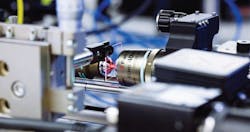Advanced 3D printing makes light work of mini optical communications device fabrication
Researchers at the King Abdullah University of Science & Technology (KAUST; Saudi Arabia) have made easier and more precise the fabrication of small-scale optical devices based in photonic-crystal fibers (PCFs), thanks to advanced 3D printing technology. This could ultimately help advance optical telecommunications as well as sensor technology and biomedical devices.
Using high-resolution 3D printing, the researchers fabricated a PCF-based fiber-polarizing beam splitter on the end-face of a standard single-mode fiber. At 210 µm long, it offered broadband operation in the optical telecommunications C-band. The work, part of a study published in Optica, demonstrated that optical waveguide segments based on geometrically unbound PCF designs “could be exploited as building blocks to realize miniaturized complex devices that implement advanced photonic operations.”1
“Photonic-crystal fibers offer scientists a type of ‘tuning knob’ to control light-guiding properties through geometric design,” says Andrea Bertoncini, a postdoctoral researcher at KAUST who co-authored the study. “People were not fully exploiting these properties because of the difficulties of producing arbitrary hole patterns with conventional methods.”
Tuning into advancement
The optical properties of PCFs are usually tuned by changing the size and shape of the hollow tubes or arranging them into fractal designs. These patterns are made by drawing cylindrical preforms at a centimeter-scale diameter, which feature a cross-sectional geometry that corresponds to “a scaled-up version of the desired final sub-millimeter-scale geometry of the fiber” (see Fig. 1). According to the researchers, this presents limitations when it comes to the manufacturing of PCF segments. During the drawing process, the preform geometry is generally not preserved due to material viscosity, gravity, and surface tension effects.
The team found that 3D printing the centimeter-scale fiber preforms greatly increases freedom of design, as it “avoids the drawing process that introduces so many limitations and drawbacks.” And, it “grants unprecedented design flexibility and precision in the control of the transverse and longitudinal PCF geometry.”
In overcoming the limitations with high-resolution 3D printing, the KAUST team was able to build up the PCFs layer by layer using a laser that transformed photosensitive polymers into transparent solids. Subsequently, characterizations discovered this technique could successfully replicate the geometrical pattern of several types of microstructured optical fibers at faster speeds than conventional fabrications (see Fig. 2).
The new process has also allowed the researchers to more easily combine multiple photonic units together. Bertoncini says they demonstrated this approach by 3D printing a series of PCF segments that split the polarization components of light beams into separated fiber cores. A custom-fabricated tapered connection between the beam splitter and a conventional fiber optic ensured efficient device integration.
REFERENCE
1. A. Bertoncini and C. Liberale, Optica (2020); doi.org/10.1364/optica.397281.
About the Author
Justine Murphy
Multimedia Director, Digital Infrastructure
Justine Murphy is the multimedia director for Endeavor Business Media's Digital Infrastructure Group. She is a multiple award-winning writer and editor with more 20 years of experience in newspaper publishing as well as public relations, marketing, and communications. For nearly 10 years, she has covered all facets of the optics and photonics industry as an editor, writer, web news anchor, and podcast host for an internationally reaching magazine publishing company. Her work has earned accolades from the New England Press Association as well as the SIIA/Jesse H. Neal Awards. She received a B.A. from the Massachusetts College of Liberal Arts.

